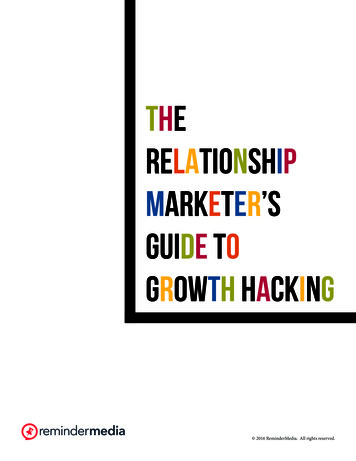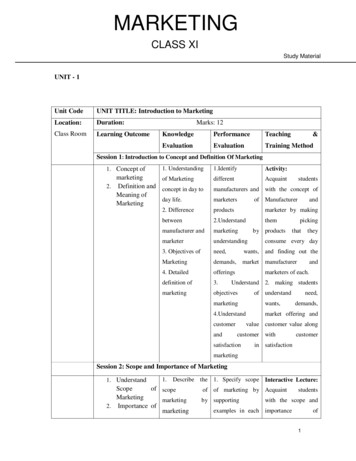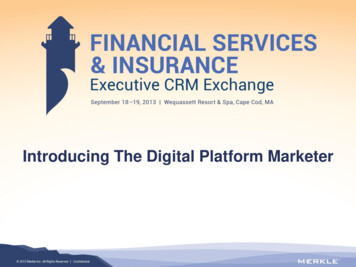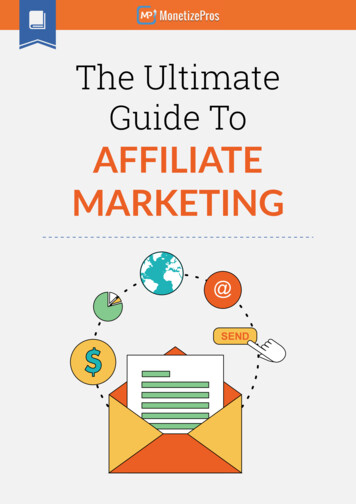
Transcription
THERELATIONSHIPMARKETER’SGUIDE TOGROWTH HACKING 2016 ReminderMedia. All rights reserved.
INTROTHE RELATIONSHIP MARKETER’S GUIDE TO GROWTH HACKINGINTRODUCTIONven if you’re notfamiliar with theterm growthhacking, you’veseen the resultsit can produce.Twitter grew from 400,000tweets posted per quarter to 100million tweets posted per quarter inonly one year. By February 2010,Twitter users were sending 50million tweets per day.During its rise to becomingthe world’s largest social mediawebsite, Facebook was consistentlyadding hundreds of thousands ofusers a day.Dropbox went from 100,000registered users to 4 million infifteen months—a 3,900percent increase!In one year’s time, Airbnb wentfrom fewer than 2 million guestnights booked to 10 million.In this e-book, you’ll discoversome of the strategies thesecompanies used to achieve theirexplosive growth. And you’lllearn how to adapt them forrelationship marketing.What is GrowthHacking? P03Leverage yourfollowing P05Find Your“A-ha!” Moment P07Test small,and scale P09Automate whenpossible P11 2016 ReminderMedia. All rights reserved.
P03THE RELATIONSHIP MARKETER’S GUIDE TO GROWTH HACKINGWHAT IS GROWTH HACKING?ome people claim that growthhacking is simply a buzzword. It’seasy to see why. Many of thetechniques are used by marketersof all types. But don’t be fooled bythe term hack. Growth hacking ismore than simply a bunch of tacticsand tricks. It’s not a silver bulletthat’s going to automatically doubleyour growth overnight. 2016 ReminderMedia. All rights reserved.
P04THE RELATIONSHIP MARKETER’S GUIDE TO GROWTH HACKINGIt’s more of a mindset thatguides marketing efforts. SeanEllis defines a growth hacker as “aperson whose true north isgrowth. Everything they do isscrutinized by its potential impacton scalable growth.”And he should know. He coinedthe term.Because growth hacking wasborn from the unique needs ofstart-ups, it’s a lean approach tomarketing. Instead of spending lotsof money on traditional marketingmethods, growth hackers seekinnovative ways to utilize resources.They focus on growth and scalability.You might not be a start-up, butyou can still use this approach tofuel growth in your own business.In fact, in many ways, growthhacking and relationship marketingare a perfect fit. They have manythings in common “[A growth hacker is] aperson whose true northis growth. Everythingthey do is scrutinized byits potential impact onscalable growth.”—Sean EllisBoth growth hacking and relationshipmarketing rely on an intimateunderstanding of your ideal clients.Ready to start? The next fourchapters cover the cornerstonesof an effective growth-hackingstrategy.Both can be cost-effective whendone properly.Both require efficiency. After all,you only have so much time to giveof yourself. 2016 ReminderMedia. All rights reserved.
P05THE RELATIONSHIP MARKETER’S GUIDE TO GROWTH HACKINGLEVERAGE YOURFOLLOWINGhen you don’thave a hugebudget (or youwant to stretchit further),you’re forced tofind alternativesto traditionalcustomer acquisition. Luckily,you have a greatsource of newbusiness already inplace: your clients.Tapping into your relationships is not only cost-effective, it’sextremely powerful. Your clientsalready know you. They can speakon your behalf. And their word willcarry plenty of weight with theirfriends and colleagues.Here are two classic examplesof growth hacks that drove hypergrowth using this principle:HotmailWhile web-based e-mail was a newconcept when Sabeer Bhatia andJack Smith launched Hotmail, theywere not the only game in town.And they were not the best-funded,either. Juno spent 20 million inmarketing and advertising.Hotmail’s entire seed funding wasonly 300,000.Yet Hotmail was able to bring onthree times as many users in halfthe time. Much of its success wasdue to one simple line of text: GetYour Free E-mail at Hotmail. 2016 ReminderMedia. All rights reserved.
P06THE RELATIONSHIP MARKETER’S GUIDE TO GROWTH HACKINGAccording to Dale Carnegie, only 11% of salespeople ask for referrals—even though91% of customers say they’d give them.Adding this link to the bottom ofevery e-mail that Hotmail users sentprovided free advertising for theservice. The impact was immediate,dramatic, and far-reaching. Newusers brought in new users, whobrought in new users of their own.Suddenly, Hotmail was explodingall over the world. It quickly becamethe largest e-mail provider inSweden. In India, it took merelythree weeks to gain 100,000 users.Those results never would havebeen possible if Hotmail hadfollowed through on its originalplan to promote the service viabillboards and radio.DropboxLike Hotmail, users loved Dropbox.But traditional advertising wasproving ineffective. For example,Dropbox was spending 233 to 388 for every customer brought invia Adwords. That was double ortriple the price of the product.The problem wasn’t thatAdwords was bad. It was just a badfit. Typical Dropbox users don’t seethe need for the service until theyexperience it. Most often, thathappens when they are introducedto it by a friend. So the folks atDropbox set about making thathappen more often.Introducing a two-sidedincentive increased Dropbox’sreferrals 60 percent. A two-sidedincentive benefits both the personreferring the service and the personwho was referred. In this case, bothparties receive extra disk space.How you can applythis principle torelationship marketingRelationship marketers knowthe value of referrals, so thisgrowth-hacking principle shouldmake sense. The trick is figuringout how to do it more consistently.According to Dale Carnegie, only11 percent of sales people ask forreferrals, even though 91 percent ofcustomers say they’d give them.One caveat: your ability toleverage your clients is directly tiedto their level of engagement andexcitement over your offering which brings us to the next growthhacking principle you need to use. 2016 ReminderMedia. All rights reserved.
P07THE RELATIONSHIP MARKETER’S GUIDE TO GROWTH HACKINGFIND YOUR“A-HA!” MOMENT 2016 ReminderMedia. All rights reserved.
P08THE RELATIONSHIP MARKETER’S GUIDE TO GROWTH HACKINGe’d alllike tothinkthat ourclientsrave aboutus fromthemomentwe sellthem onour service.But thingsusually don’t work that way. Startups often discover that excitementwanes, and the people who signedup for their product or service dropoff. The same thing can happen toyou when you lose touch withyour clients.Growth hackers know thatlasting excitement comes fromaction, not ideas. There are certainpoints in the experience whenthings just click, and the customer ishooked. That’s the “a-ha!” moment.Finding it is the key to turning yourclients into evangelists.Consider these examples fromtwo of the largest social medianetworks in the world:There are certain pointsin the experience whenthings just click, andthe customer is hooked.That’s the “A-ha!” moment.Twitter’s team optimized for thismetric, its user retention andengagement rates rose significantly.Or maybe it’s after a client sharesyour social media update five times.Find out what it is for your clients,and you have a clear goal to achieve.Try to guide your clients to thatFacebookmoment as quickly as possible. Let’sThe team at Facebook was able tocontinue with the hypotheticalgrow the product exponentially bymetric above: your goal would befinding and focusing on its “a-ha!”to figure out how to startmoment: reaching seven friends inconversations. You could use anten days. In fact, Chamathinteresting story or anecdote as anPalihapitiya, who headed Facebook’sicebreaker. Or you could sharegrowth team, said it was the mostsomething that you know is ofimportant factor in puttinginterest to your client, such as aFacebook on the path to one billionspecific recipe.users. This specific metric is rootedTwitterWhen defining your “a-ha!”in the core value of the product. Themoment, be as specific as possible.Looking through their analytics, theusers “get it” by experiencing it.Notice how the examples abovegrowth team at Twitter discoveredinclude specific numbers? Thisthat people who followed at leastHowyoucanapplyhelps keep it simple and actionable.ten other people on Twitter wereIt will probably take a littledramatically more likely to be active this principle toexperimenting to get it right,users than those who followed lessrelationship marketingwhich is why the next principlethan ten.Relationship marketers can use thisis so important.That “a-ha!” moment became thesame strategy to strengthen theirfocus of their efforts. It was theclient relationships. Your “a-ha!”impetus for the “People to Follow”moment might be after the thirdfeature, among other things. Onceconversation not related to work. 2016 ReminderMedia. All rights reserved.
P09THE RELATIONSHIP MARKETER’S GUIDE TO GROWTH HACKINGuge growth starts as smallgrowth. Actually, it oftenstarts as no growth at all.The fact is, while growthhackers can hypothesizewhat’s going to work, younever know until you testit. Sean Ellis evenadmitted most growthideas fail. That’s why hebelieves it’s vital to explorea wide variety of options.TEST SMALL,AND SCALE“Since mostgrowth ideasfail, itbecomescritical totest a lotof them.”—Sean Ellis 2016 ReminderMedia. All rights reserved.
P10THE RELATIONSHIP MARKETER’S GUIDE TO GROWTH HACKINGWhen you find what works, thenyou can implement it on a largerscale. That’s what all the successfulgrowth hackers did in the examplesthroughout this e-book. Facebookand Twitter found their “a-ha!”moments by analyzing what wasworking, and they closely testeddifferent ways to amplify thoseeffects.Dropbox had tried all sorts ofmarketing techniques to grow itsbusiness, including search enginemarketing, affiliate advertising, anddisplay ads. All failed before itfound its growth engine. In fact,founder and CEO Drew Houstoncalled those early results“horrendous.”Even with the winners, growthhackers test and optimize ways tomake them more effective. Take alook at Dropbox’s website. Thehomepage is focused entirely onsign-ups. And Dropbox makes iteasy to share and refer its solution.None of that is by accident. It’s allcarefully tested.How You Can Applythis principle torelationship marketingRelationship marketing is toopersonal to effectively run the kindof structured tests you see fromInternet start-ups. You’re marketingone-to-one, after all, not simplytrying to get a user base to takeaction on a landing page. But thatdoesn’t diminish your need tomeasure and learn.Here’s what you need to do:Develop ideas for strengtheningrelationships. Are you going tosend an e-mail newsletter? Sharecontent on social media? Mail acustom magazine? Think of asmany ideas as you can.Try them out with your clients.Choose a good cross-sample ofyour client list, and commit totrying each idea on enoughclients to yield valid results. Youalso want to make sure you giveyour ideas enough time to work.Record your results. Referrals arean obvious metric, but there areother performance indicatorsyou should track as well. Did youlearn more about you clients’likes and dislikes? Did youreffort result in a successfulfollow-up conversation?Anything that indicates growthin the relationship is importantto measure.Analyze the results. If you takegood notes, you can see whichefforts are giving you the bestreturn on your investment.Focus more of your time andbudget on those, and scale backthe rest.Of course, all this takes time andeffort, which can be difficult amidyour other business responsibilities.We’ll talk about the solution in thenext chapter. 2016 ReminderMedia. All rights reserved.
P11THE RELATIONSHIP MARKETER’S GUIDE TO GROWTH HACKINGAUTOMATEWHENEVERPOSSIBLEet’s face it; you only haveso much time in a day.And if you’re anything likemost of the relationshipmarketers we work with,you have about a millionand one things to do.Growth hackers face thesame challenge. To meet it,they come upwith innovativeways to automateas many tasks as possible.They send automatic e-mailstriggered by client actions. Theydevelop programs to streamlineprocesses. They look for anythingthey can use to meet their objectiveswith limited manpower.Airbnb is a great example. Whenit was first trying to gain traction inthe marketplace, it developed thisingenious hack: it reverseengineered a way to integrate theirservice with Craigslist. Listings onAirbnb were automatically postedto Craigslist as well. So whenpeople visited Craigslist searchingfor a place to stay, they foundAirbnb listings with a link to theAirbnb site.The hack also allowed Airbnb toreach Craigslist posters by e-mail topromote the ability to post to bothplatforms without any extra effort.Doing this manually would havebeen impossible for what, at thetime, was a small company. Soautomation was a key componentin its service gaining traction. 2016 ReminderMedia. All rights reserved.
P12THE RELATIONSHIP MARKETER’S GUIDE TO GROWTH HACKINGYour time is valuable. If you’re spendingtoo much of it on tasks that don’tcontribute to profit, you’re wasting money.How You Can Applythis principle torelationship marketingChances are you’re not going tohave the coding skills to pull off ahack like Airbnb’s. But that doesn’tmean you can’t find ways to build agrowth machine with the resourcesyou have available. Here are a fewways to do it:Turn to othersoutsourcing those tasks so you canfocus on building profitablerelationships. You can findaffordable virtual assistants on sitesincluding fiverr or Upwork.Many of the companies with whichyou work can provide a value beyondthat of their products by providingtime-saving resources and support.We do that ourselves—by assigninga personal coach and dedicatedsupport team to every client.Your time is valuable. If you’reCustomize insteadspending too much of it on tasksthat don’t contribute to profit, you’re of creatingwasting money. Often, you canThere are numerous ways to stayachieve a better return byconnected with clients. Some—like branded publications—areimpressive, and they work well.However, developing one fromscratch is not practical. Theinvestment you’d have tomake in editorial, production,graphic design, printing, andpostage would be prohibitive. Yetour clients are still able to usethese tools. Their secret?They don’t create theirmagazines from scratch. Theycustomize components that arealready in place, leveraging theexpertise and effort of others. Itsaves them time and money, andfrom their client’s view, themagazine is unique to the business. 2016 ReminderMedia. All rights reserved.
P13THE RELATIONSHIP MARKETER’S GUIDE TO GROWTH HACKINGCONCLUSIONABOUTContact Us ReminderMedia 866.458.4226info@remindermedia.com www.remindermedia.comrowth hacking is allabout workingsmarter to growyour business. Ifyou rely onreferrals, thenrelationships areyour business.Focus ongrowing andstrengtheningthem.Use the principlesoutlined in this e-book to guideyour strategies, and come up withyour own as well. With a little hardwork and dedication, you’ll begrowth hacking your way tomore referrals.ReminderMedia has beenproviding unique, top-of-the-lineclient follow-up tools since 2003.With an established foundation inrelationship marketing—andproducts like American Lifestylemagazine, we’ve developed thetechniques and innovations thatallow clients in every industry totake advantage of referrals andrepeat business like no othersolution on the market. 2016 ReminderMedia. All rights reserved.
growth. Everything they do is scrutinized by its potential impact on scalable growth." And he should know. He coined the term. Because growth hacking was born from the unique needs of start-ups, it's a lean approach to marketing. Instead of spending lots of money on traditional marketing methods, growth hackers seek











